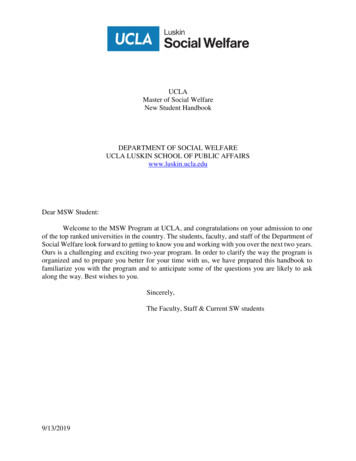
Transcription
Kegel Exercises for MenThe following information is based on the general experiences of many prostate cancerpatients. Your experience may be different. If you have any questions about whatprostate cancer treatment services are covered by your health insurance, please contactyour health care provider or health insurance provider. This education material wasmade possible by a Grant from the CaliforniaPleasefeel freeto readAntitrustonly thoseof thebookletyou settlementneed now.fundsYou toDepartmentof Justice,LawpartsSection,fromlitigationdon’tto read everythingrightcancernow. orYoucanalways read more later.benefitneedCaliforniansdiagnosed withtheirfamilies.Table of ContentsWhat Will I Learn By Reading This Booklet?. 2What Are Pelvic Floor Muscles? . 3What are Kegel Exercises?. 4Why Should I Do Kegel Exercises. 5How Do I Find My Pelvic Floor Muscles? . 6How Do I Do A Kegel Exercise?. 7How Often Should I Do My Kegel Exercises? . 8When Should I Do The Kegel Exercises?. 9Can I do Kegel Exercises If I Have A Catheter? . 10Will My Urine Leakage Stop if I Do The Kegel Exercises? . 11What Have I Learned By Reading This Booklet?. 12Key Words. 13-14
What Will I Learn By Reading This Booklet?When you have prostate cancer surgery or radiation therapy the muscles that help youcontrol your urine flow may be weakened. When this happens you may haveincontinence. Incontinence is when you leak or pass urine when you do not want to.This is a very common side effect or unwanted change of prostate cancer treatment.The good news is that there is a simple exercise, called a Kegel (Key-gul) exercise,you can do to help strengthen your muscles. This exercise will help you have morecontrol over your urine flow after your prostate cancer treatment. In this booklet youwill learn: What a Kegel exercise is Why you should do Kegel exercises How to find your pelvic floor muscles How often you should do your Kegel exercisesIt is important for you to think about and plan how you will take care of yourselfbefore and after your prostate cancer treatment so that you can keep doing as many ofyour normal activities as possible.Words that appear in bold (dark text) can be found in the “Key Words” section at theend of this booklet.2
What Are Pelvic Floor Muscles?Your pelvic floor muscles are a network of muscles that support your bladder and helpyou control your urine flow. There are three pelvic muscles:1. The bladder. Your bladder is a muscle shaped like a balloon and holds yoururine.2. The sphincter muscles. These muscles help you open and close your urethra,the tube that drains urine from your bladder. And,3. The pelvic floor muscle [also known as the pubococcygeus (pu-bo-kak-sij-eus) or PC muscle] supports your bladder and rectum and helps control yoururine flow.Picture of Pelvic Floor MusclesSphincter muscle3
What Are Kegel Exercises?Kegel exercises are easy exercises you can do before and after your prostate cancertreatment to help strengthen your pelvic floor muscles. These muscles help controlyour urine flow. Kegel exercises are one of the most effective ways of controllingincontinence without medication or surgery.4
Why Should I Do Kegel Exercises?The prostate is a gland, about the size of awalnut, located under the bladder surroundingthe upper part of the urethra. The urethra is a tubethat carries urine through the penis to the outside of the body. There are many musclesthat surround the prostate gland. These muscles may be weakened during yourprostate cancer treatment. This may cause you to have urine leakage also known asincontinence. Building up the strength in your pelvic floor muscles can help you gainbetter control of your bladder and urine flow. Remember, that just as it takes time tobuild your biceps and strengthen any other muscle in your body, it takes time tostrengthen muscles in your pelvic floor.5
How Do I Find My Pelvic Muscles?In order to help strengthen you pelvic floor muscles, it isimportant that you take time to make sure you are exercisingthe right muscles. It may take you several tries to find yourpelvic muscles. So, take your time.There are several ways that you can find your pelvic floor muscles. One way is to:1.Try to stop and start your urine stream while you stand at your toilet tourinate (pee). Try to do this two or three times.Another way to find your pelvic floor muscles is to:1.Imagine that someone walks in to your bathroom while you are urinating(peeing) and you need to stop your urine flow.2.Try to stop your urine flow.The muscles you use to stop your urine flow are your pelvic floor muscles. These arethe muscles you want to strengthen before and after your prostate cancer treatment.6
How Do I Do A Kegel Exercise?Now that you have located your pelvic floor muscles, you can exercise them evenwhen you do not have to urinate (pee) by following these simple steps:1. Tighten and hold your pelvic floor muscles for five seconds (count 1 onethousand, 2 one thousand, 3 one thousand, 4 one thousand, 5 one thousand).2. Relax your pelvic muscles.You have just done one Kegel exercise. You should plan to do 10 to 20 Kegelexercises three to four times each day.Another way to tighten your pelvic floor muscles is to:1. Squeeze the muscles in your anus (like you are holding a bowel movement).2. Relax your pelvic floor muscles after each attempt.3. Repeat this exercise 10 to 20 times.When you do your Kegel exercises, remember Do not hold your breath. Do not push down. Squeeze your muscles together tightly and imagine that youare trying to lift this muscle up. Do not tighten the muscles in your stomach, buttocks, or thighs. Relax your pelvic floor muscles between each squeeze.7
How Often Should I Do Kegel Exercises?When you first start doing your Kegel exercises, you may not be able to repeat theexercise 10 to 20 times. This is ok. It is much better for you to do fewer Kegelexercises that make your pelvic floor muscles stronger, than to do more exercises thatdo not work the muscle in the right way. As you get better at doing your Kegelexercises, slowly increase the number of times you repeat the exercise until you reach20. Your goal should be to do 20 Kegel exercise three to four times each day.The great thing about Kegel exercises is that you can do them anytime you want to dothem. No one can tell that you are doing these exercises. You do not need any specialequipment to do Kegel exercises. You can do your Kegel exercises before you get upin the morning, at lunchtime, at suppertime, and at bedtime. You can do them whileyou are watching TV or reading. Some men put notes on their refrigerator or on theirbathroom mirror to remind them to do their Kegel exercises. Kegel exercises can helpboth men and women. Some men’s partners do the exerciseswith them. The more you do them, the stronger your pelvic floormuscles will become.8
When Should I Do My Kegel Exercise?It can take six weeks or longer to strengthen your pelvic floor muscles so it is best tostart doing your Kegel exercises before you have prostate cancer treatment. This willhelp you become better at doing the Kegel exercises and strengthen your pelvic floormuscles before your treatment starts. Remember, your pelvic floor muscles are likeany other muscle in your body. It takes regular exercise and time to strengthen them.Plan For Doing Your Kegel Exercises When will you practice your Kegel exercises? How will you get in touch with your doctor or health care teamif you have questions about Kegel exercises?Doctor’s NameDoctor’s office phone numberDoctor’s pager9
Can I do Kegel Exercises If I Have A Catheter?A catheter is a thin rubber tube placed in your body to drain urine from your bladderout through your penis. Do not do any Kegel exercises if you have a catheter in yourpenis.Start doing your Kegel exercises according to the instructions above as soon as thecatheter is taken out of your penis. After your catheter is removed you may experiencesome urine leakage (incontinence) when you stand up, cough, sneeze, laugh, or liftsomething. You will probably need to use incontinence pads for a while. However,doing Kegel exercises may help you control your urine flow sooner. If you have urineleakage when you stand up, cough, sneeze, laugh, or lift something, try doing a Kegelexercise. This may keep you from leaking urine.10
Will My Urine Leakage Stop If I Do Kegel Exercises?Most men gain control of their urine leakage (incontinence) within nine to 12 monthsafter their surgery. Studies with men show that Kegel exercises help lessen urineleakage. However, each man’s healing time is different.Do not become discouraged if you have urine leakage. If you do your Kegel exerciseson a daily basis, you can expect to see some results. You may have a greatimprovement or you may help keep your urine leakage from getting worse. You willneed to continue doing your Kegel exercises each day so that your pelvic floor musclesstay strong.If you have any questions or concerns about urine leakage (incontinence), how to do aKegel exercise, or if you would like to know about other things that may help withurine leakage, please talk to your doctor or your healthcare team.11
What Have I Learned By Reading This Booklet?In this booklet, you learned about: What a Kegel exercise is Why you should do Kegel exercise How to find your pelvic floor muscles How often you should do your Kegel exercises.If you have any questions, please talk to your doctor or health care team. It isimportant for you to think about and plan how you will take care of yourself beforeand after your prostate cancer treatment. This knowledge will help you take better careof yourself and feel more in control so that you can get the most from your treatment.12
Key WordsAnus: the opening through which stool passes out of your body. The act ofpassing stools is called a ‘bowel movement.’Bladder: a muscle shaped like a balloon and holds your urine.Bowel movement: The act of passing stool.Catheter: a thin rubber tube placed in your body to drain urine from your bladder outthrough your penis.Incontinence: when you leak or pass urine when you do not want to.Kegel (Key-gul) exercise: exercises strengthen the pelvic floor muscles, whichsupport the bladder and bowel.PC muscles (also known as Pelvic floor or pubococcygeus muscles): muscles thatsupport your bladder and rectum and helps control your urine flow.Pelvic floor muscles (also known as the pubococcygeus (pu-bo-kak-sij-e-us) or PCmuscles): muscles that support your bladder and rectum and helps control your urineflow.Prostate: a gland, about the size of a walnut, located under the bladder surroundingthe upper part of the urethrapubococcygeus (pu-bo-kak-sij-e-us) muscles (also known as pelvic floor or PCmuscles): support your bladder and rectum and helps control your urine flow.13
Rectum: The outermost portion of the large intestine. Stools are stored in the rectumuntil they are passed out of the body through the anus.Semen: The fluid that comes out of your penis at the climax of sex.Side effect: unwanted changes in your body caused by your prostate cancertreatment.Sphincter muscles: muscles which help open and close your urethra, the tube thatcarries urine and semen through the penis to the outside of the body.Stool: the fecal matter that comes out at each movement of your bowels.Urethra: a tube that carries urine through the penis to the outside of the body.14
5 Why Should I Do Kegel Exercises? The prostate is a gland, about the size of a walnut, located under the bladder surrounding the upper part of the urethra. The urethra is a tube that ca










